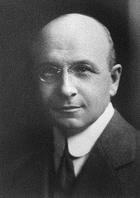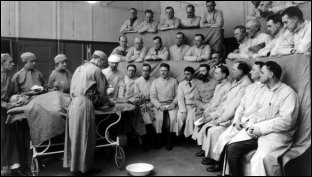
 Alexis Carrel was born at Lyons, France, on June 28, 1873.
He was the son of a business man, also named Alexis Carrel, who
died when his son was very young.
Alexis Carrel was born at Lyons, France, on June 28, 1873.
He was the son of a business man, also named Alexis Carrel, who
died when his son was very young.
Alexis was educated at home by his mother Anne Ricard, and also
at St. Joseph School, Lyons.
In 1889 he took the degree of Bachelor of Letters at the University
of Lyons; in 1890 the degree of Bachelor of Science and in 1900
his Doctor's degree at the same University. He then continued his
medical work at the Lyons Hospital and also taught Anatomy and Operative
Surgery at the University, holding the post of Prosector in the
Department of Professor L. Testut. Specializing in Surgery, Carrel
began experimental work in this subject in Lyons in 1902, but in
1904 he went to Chicago and in 1905 worked in the Department of
Physiology in the University
of Chicago under Professor G. N. Stewart. In 1906 he was attached
to the Rockefeller
Institute for Medical Research, New York, as an Associate Member,
becoming a Full Member in 1912. In this Institute he carried out
most of the experiments which earned him, in 1912, the Nobel Prize
in Physiology or Medicine.
During the 1914-1919 War, Carrel served as a Major in the French
Army Medical Corps and at this time he helped to devise the well-known
Carrel-Dakin method of treating war wounds, which was widely used.
Carrel's researches were mainly concerned with experimental surgery
and the transplantation of tissues and whole organs. As early as
1902 he published, in the Lyons Medical, a technique for
the end-to-end anastomosis of blood vessels and in 1910 he demonstrated
that blood-vessels could be kept for long periods in cold storage
before they were used as transplants in surgery. Earlier, in 1908,
he had devised methods for the transplantation of whole organs and
later, in 1935, in collaboration with Charles Lindbergh, the airman
who was the first to flow across the Atlantic, he devised a machine
for supplying a sterile respiratory system to organs removed from
the body, Lindbergh having solved the mechanical problems involved.
He discussed this aspect of his work and its implications in his
book The Culture of Organs. Carrel also published the well-known
book entitled Man, the Unknown and, in collaboration with
Georges Debelly, a book on Treatment of Infected Wounds.
 In collaboration with the French surgeon Theodore Tuffier, who was
a pioneer of thoracic surgery, Carrel performed on the heart a successful
series of valvotomies, and in collaboration with Burrows he grew
sarcoma cells in tissue cultures by the technique of Harrison.
In collaboration with the French surgeon Theodore Tuffier, who was
a pioneer of thoracic surgery, Carrel performed on the heart a successful
series of valvotomies, and in collaboration with Burrows he grew
sarcoma cells in tissue cultures by the technique of Harrison.
Carrel was honoured by memberships of learned societies in the U.S.A.,
Spain, Russia, Sweden, The Netherlands, Belgium, France, Vatican
City, Germany, Italy and Greece, and by honorary doctorates of the
Universities of Belfast,
Princeton,
California and New
York, and Brown
and Columbia
Universities. He was a Commander in the Legion d'Honneur of France
and in the Leopold Order of Belgium, a Grand-Commander in the Swedish
Order of the Polar Star, and the recipient of other decorations
in orders from Spain, Serbia, Great Britain and the Holy See.
He was married to Anne-Marie-Laure Gourlez de La Motte, the widow
of M. de La Meyrie. They had no children.
In 1939, when the Second World War broke out, Carrel went to France
as a member of a special mission for the French Ministry of Health,
a post which he held for a year. He then became Director of the
Carrel Foundation for the Study of Human Problems which was set
up by the Vichy Government. While holding this appointment he died
in Paris on November 5, 1944.
Alexis Carrel Biography by http://www.nobel.se/index.html
Privacy Policy | Terms and Conditions | This site is not affiliated with the Lindbergh family,
Lindbergh Foundation, or any other organization or group.
This site owned and operated by the Spirit of St. Louis 2 Project.
Email: webmaster@charleslindbergh.com
® Copyright 2014 CharlesLindbergh.com®, All rights reserved.
Help support this site, order your www.Amazon.com materials through this link.

